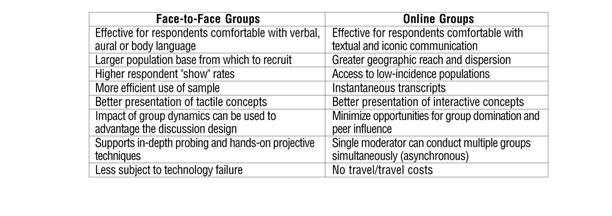Compare and contrast
Editor's note: Lisa Kindig is vice president of The Qualitative Institute at Strategic Marketing Corporation, a Bala Cynwyd, Pa., research firm. She is also a member of the QRCA.
For some qualitative market research studies, using face-to-face and online methods in tandem can leverage the benefits and mitigate the drawbacks of both. To design efficient and effective projects, market research buyers and sellers must partner and consider all available methods for understanding the experiences, opinions, and motivators of targeted market segments.
At present, only a handful of studies compare online and traditional qualitative techniques. Since little formal research exists, Strategic Marketing Corporation (SMC) and Itracks International, Inc. conducted a study to compare face-to-face focus groups with both asynchronous (bulletin board) and synchronous (chat-style) online groups. The findings from this study match SMC's anecdotal experiences with face-to-face and online qualitative research.
Face-to-face research offers some distinct advantages over online methods. First, the nature of face-to-face discussion provides an effective forum for respondents who best communicate through speaking, listening and reacting to others, or body language. Traditional groups allow for the presentation of tactile, three-dimensional concepts, and support the use of hands-on projective techniques. In addition, while still permitting interactivity through demo CDs and live Web connections in the focus group room, traditional groups limit the potential for technology failure.
Also, respondent show rates are higher for face-to-face research: 50 percent higher than asynchronous online groups, and 100 percent higher than synchronous online groups. Traditional qualitative research also offers more efficient use of sample; recruiting for online groups requires five to 10 times as many pieces of usable sample as recruiting for face-to-face groups. Finally, recruiting for traditional groups draws from a larger population base, as lack of online access does not limit participation.
At the same time, online qualitative methods provide unique advantages over face-to-face techniques. Online groups allow geographic diversity, and can involve respondents not easily recruited for traditional groups. This includes participants who are homebound or from areas with low population density, as well as those with low-incidence conditions or characteristics (such as specific types of illness or expertise). In our study, respondents in traditional groups came solely from the Philadelphia area. Online, respondents represented 25 states, including areas not routinely visited for market research.
Online groups reduce the opportunity for individual respondents to dominate the discussion, and the influence of group dynamics also fades. Our research design included physician-only, patient-only, and mixed physician-patient face-to-face focus groups, and mixed physician-patient online groups. While our results indicate that we successfully elicited honest, direct dialogues in all of these research environments, it took much more moderator sophistication and skill to mix physicians and patients face-to-face than to mix them online.
Other advantages of online groups include the opportunity to view and discuss dynamic online concepts in a live interactive environment, the ability to view and conduct groups from any location, and the immediate availability of discussion transcripts. Finally, the nature of online discussion provides an effective forum for those respondents who are not comfortable with face-to-face interaction, or whose best communication modes are textual or iconic.
It is important to note that we did not experience differences in project cost and speed of execution between our face-to-face and online groups. This also matches our prior anecdotal experience. We suggest that the nature of the respondents and the research objectives are stronger drivers of cost and speed than the medium employed. For less complex general consumer studies, online research may offer a faster, less expensive solution. However, for studies with highly specific or low-incidence recruiting criteria, or for those that target professionals, experts, or opinion leaders, we suggest that cost and speed are comparable across all methods.
Perhaps the most interesting outcome of the study is that regardless of method, respondents overall revealed the same perceptions, opinions, and concerns about the impact of consumer-targeted medical and health information on the physician-patient relationship. Despite industry debate over the quality of findings from current online methods, it is important to remember that respondents want to be understood, regardless of the research environment, and they make the effort to communicate clearly. Aware that they cannot be seen or heard, online respondents adopt new ways to share tone of voice and feeling through capitalization, shorthand, punctuation, emoticons, and precise wording.
At the same time, although all these research methods ultimately lead to the same conclusions, each contributes a different type of understanding to the bottom-line findings. Face-to-face respondents employ more "storytelling" to describe and characterize their feelings and experiences. Participants in online asynchronous groups engage in provocative debates and provide more richly textured explanations of opinions and beliefs. The online synchronous method encourages intensely direct and lean communication; these respondents immediately cut to the heart of the issue at hand with utter candor. SMC observes that combining these qualitative methods can result in overall research conclusions and marketing implications of much greater depth and breadth.
Therefore, depending on the research objectives, target market under study, concept medium, and complexity of research scheduling, complementary pairing of face-to-face and online methods may offer research buyers and sellers the most efficient and effective way to gather information.
 |
